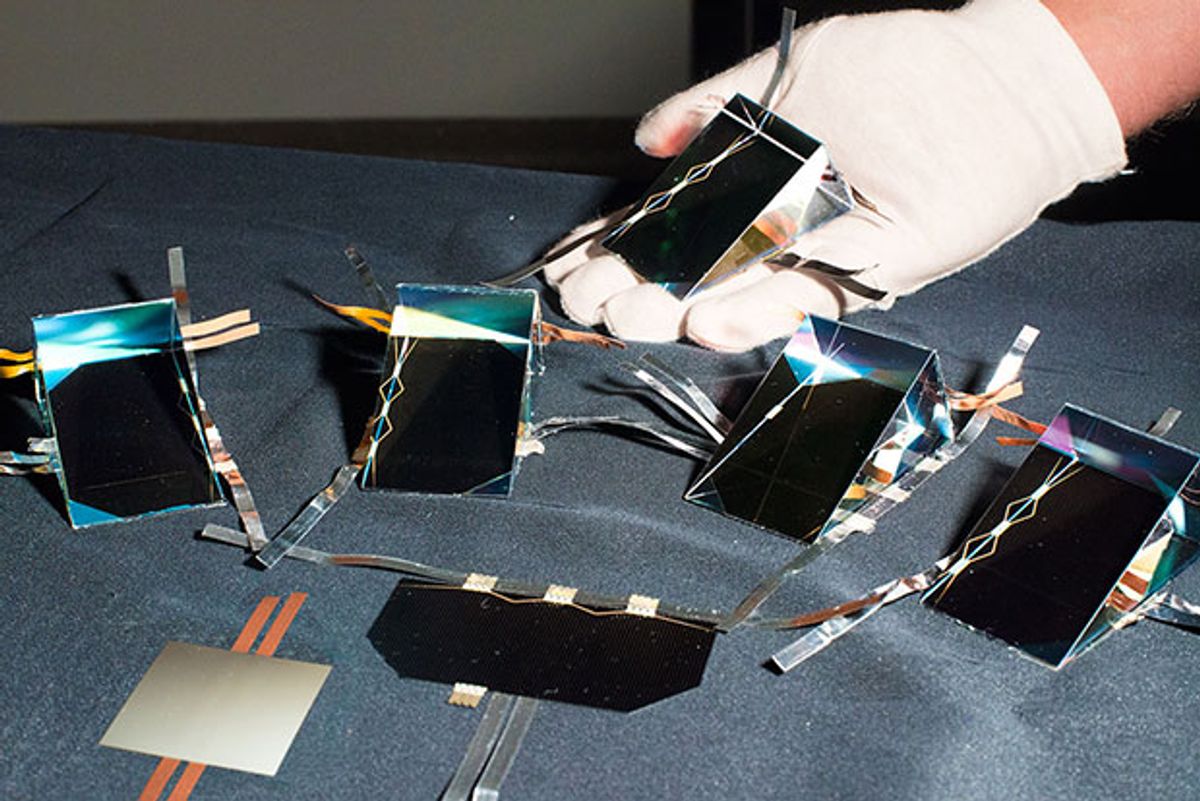Researchers in Australia have built a solar cell with light conversion efficiency far in excess of commercial solar cells.
Mark Keevers and Martin Green of the University of New South Wales say their four-junction mini-module breaks the world record for efficiency for that type of solar cell. The cell converted 34.5 percent of the sunlight striking it into electricity, the two said at a press conference on Tuesday. That’s well on the way to the 53-percent theoretical maximum efficiency of such a device. Most commercially available silicon photovoltaics—the types found on rooftops and in solar farms—top out at around 16 to 18 percent efficiency.
The researchers have not published a peer-reviewed paper on their results, but the efficiency was certified by the National Renewable Energy Laboratory.
The device consists of a triple-junction cell comprising three semiconductor materials: indium-gallium-phosphide, indium-gallium-arsenide, and germanium. Each of those absorbs different wavelengths of sunlight. Additional wavelengths are reflected toward a fourth layer made of silicon. The overall effect is that, because the cell can handle a much wider range of wavelengths than is possible with a silicon cell alone, more of the sunlight striking the cell is converted to electricity.
Because the cell is shaped like a prism, says Green, who is director of the Australian Centre for Advanced Photovoltaics at UNSW, it passively gathers light coming from a wide range of angles. The prism also guides the light from the triple-junction cell on one side to the silicon on the other, Martin said in an email.
The device will likely cost more to make than conventional solar cells, both because of the complexity of the design and the cost of the materials. But Green says the manufacturing cost may be offset by increased efficiency. He adds that he would like to use this design with lower cost materials such as copper-zinc-tin-sulfide and perovskites—a class of materials increasingly seen as well suited for photovoltaics.
Green and Keevers, a senior researcher at the center, are aiming for a cell with a conversion efficiency of 40 percent. They’d already achieved that with a cell that used a lens to concentrate sunlight, but this design would not require a lens.
Many people like to claim world records for solar cell efficiency. In March, First Solar, of Tempe, Ariz., claimed a record for cadmium-telluride solar cells when it achieved an efficiency of 22.1 percent. Alta Devices, of Sunnyvale, Calif., which makes solar cells for unmanned aerial vehicles, announced in April that a dual-junction device made of gallium-arsenide and indium-gallium-phosphide had reached an efficiency of 31.6 percent. And a collaboration between Soitec, a French semiconductor material company; CEA, a French government research agency; and the Fraunhofer Institute for Solar Energy Systems in Germany, announced a cell with 46- percent efficiency in December 2014. The cell they produced—a four-junction cell that uses gallium, indium, and germanium and relies a concentrating lens—is very expensive and is mainly sold to NASA for applications in space.



